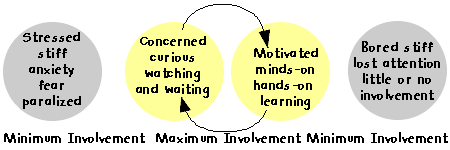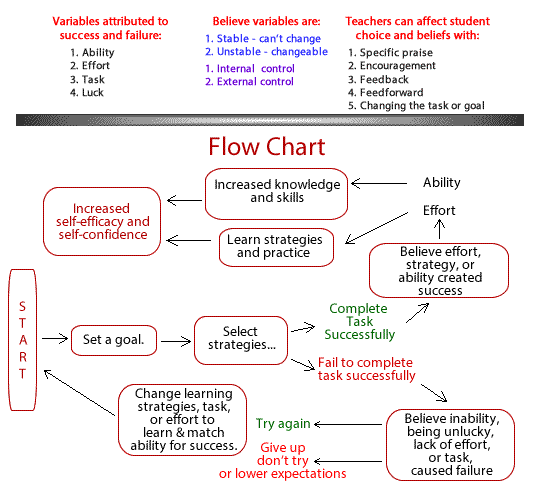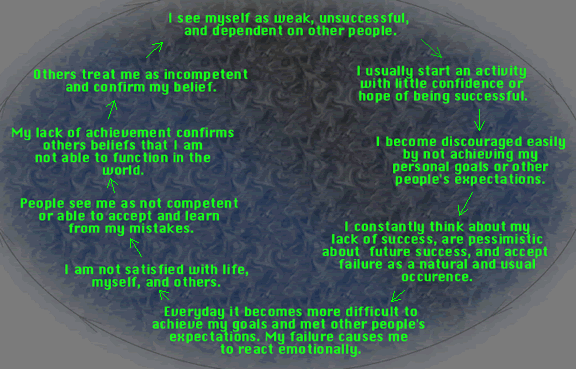Motivational theory, self-efficacy, attribute theory
- Attributes for success that contribute to self-efficacy
- Research on success & failure
- Suggestions to motivate, set goals, and develop self-efficacy
- Procedure to model and achieve self-efficacy
- Procedure for achieving self regulation
- Procedure for setting & achieving goals
- Self-talk
- Maladaptive behavior or self-limiting behavior
- Interventions suggestions for maladaptive behaviors
- 4 Categories of maladaptive behavior
- Attention-getting behaviors
- Power seeking
- Revenge behaviors
- Display-of-inadequacy behaviors
Motivation is the force that drives a person to do something. It includes emotions such as: hope, initiative, drive, intensity, self-efficacy, and persistence; that inhibit, neutralize, or promote goal-directed behaviors.
Therefore, the purpose for motivating ourself and others is to find the emotions, which will encourage and sustain us, or them, to acquire expectations (hope) to be able to set goals, have enough self-efficacy to develop the necessary ability, and to find access to enough opportunities to achieve our goals.
Emotions, which are internal.
Learners choose to learn or escape from learning depending on their needs (see Maslow's hierarchy of needs), how they are cared for, their expectations, hope for success, ability to set goals, their self-efficacy, and their opportunities for success or failure.
If learners believe in their self-efficacy to learn, they will be hopeful and eagerly choose to be active and learn new things, both in and outside of school.
If they believe they are incapable of learning and powerless to change, they will lose hope for success and choose to be inactive, not involved, and withdraw from learning experiences and their performance is reduced.
In actuality people are somewhere between two extremes of empowered and hopeful or helpless and hopeless. This is represented by the line between these two extremes in this diagram.

Outstanding teachers use interactions that demonstrate they care and want their students to be successful. They do so when they invite, encourage, and assist learners to set achieveable goals, which motivate their participation by giving them hope of success.
Motivation, achieved by manipulation of the environment to assist learners with new experiences, starts with the learners current understandings and challenges them to achieve with progressive learning experiences, maintaining high expectations, assisting them to resolve conflicts and providing hope that they will achieve success.
Learner's involvement is crucial and degrees of involvement are illustrated along a continuum from helpless and powerless with a belief of self-efficacy as in the following model.

Learning is an integral part of the total body and brain physiology. This physiology is controlled not only by the intellectual responses a person is capable of making, but the perceptual and emotional responses they make consciously or subconsciously, which are beyond their control.
However, both conscious and subconscious thoughts influence their actions or inactions. Responses, which are not singular in nature, but are connected to other emotions, which affect their expectations (hopes), ability to set goals, self-efficacy, and opportunities for success or failure. Connections like waves or explosions that ripple change throughout the body creating internal changes that initiate and accompany external observable behaviors.
The point is, we must recognize that what appears as a simple external response, is accompanied by internal chemical and neurological responses that have been constructed by each individual from a combination of many internal interactions. Interactions based on experiences each person has had over their lifetime. Starting with the genetic material inherited from their parents and their interactions with their environment, even before conception. These interactions, both positive and negative, have created the individual each of us is over our lifetime.
As teachers we find learners more acceptable to change than others. To understand the influences on what motivates change let's consider variables from a two notable historical theories. 
William Glasser, Choice Theory.
He identifies
five variables he claims
influence the choices
people make. They are:
- Love,
- Power,
- Freedom,
- Fun, and
- Survival.
James G. Wilson, Moral Sense.

He identifies four variables he claims influence the moral decisions people make. They are:
- Sympathy,
- Fairness,
- Self-control, and
- Duty.
Learners engage in activities or attempts to learn a behavior they value, or feel is worthwhile, and hope they can use successfully. As they participate or with draw from participation, they establish an understanding of their abilities (self-efficacy), which they will use to judge success in their participation in future activities, which they use to determine the likelihood and level of their success. The hopefulness of their success based on their expectations (hope), ability to set goals, self-efficacy, and opportunities for success or failure.
Attributes for success that contribute to self-efficacy
Self-efficacy can be understood by considering attributes that contribute to each person's perception of success
or failure to achieve their goals .
The following flow chart shows how attributes can affect self-efficacy and self-confidence. (adapted from M. Kay Alderman, 1990)

Goal setting and self monitoring (metacognition) plays an important part in cultivating self-motivation (Bandura, 1986) and self-efficacy. When learners first encounter a task they consider what their goal might be.
- They may decide the task is hopeless and decide not to try or if forced to try, elect to fail or just play along with little effort.
- They may decide a task is worthwhile or is a challenge and desire to engage in it.
- They may have successfully finished a similar task and seek similar experiences for enjoyment or to continue to gain greater understanding or to excel in particular performances for the power learning provides.
- They may be indifferent about a task , but respect or care for who is asking them to participate so they accept the opportunity to cooperate and complete the task. Or
- They may have just failed a task and have low expectations of success, but caring encourages them to try again.
Through self-talk and self-monitoring (metacognition) learners decide goals while anticipating their success or failure based on their ability, effort, the difficulty of the task, or the luck they feel they might have while attempting the task. Their anticipation of success or failure is based on these variables.
If they anticipate failure, they may reason, failure is attributed to: lack of ability, lack of effort, difficulty of the task or bad luck based on illogical reasons. What they believe contributes to their failure or success determines how they approach a task.
- If they believe success or failure requires effort and they lacked effort, then they might increase their effort to achieve the goal or set another goal that requires less effort.
- If they attribute success or lack of success on the strategies they used, they might seek and select a new strategy or give up believing they are incapable of using the strategy successfully.
A motivational theory and attribution model can be used to understand learner's reasons for success and failure to make better choices to assist them in setting goals, selecting learning strategies, encouraging hope,and positively affecting their motivation with a conversation to assist behavioral change.
The following research examples supports this.
Research Related to Attributes of Success and Failure
- Students who perceive the cause of their failure as a lack of effort or poor selection of a strategy are more likely to be motivated to set positive goals for similar tasks in the future.
- Students who perceive a cause of their failure as a result of bad luck or conditions beyond their control are less likely to be motivated to set positive goals to learn.
- Success builds on success leading to intrinsic motivation. self-confidence, and self-efficacy increasing student's efforts, risk taking, and hence learning.
- Failure that follows failure reduces intrinsic motivation and self-efficacy decreasing student's efforts, risk taking, and learning.
- Extrinsic motivation may increase motivation creating a desire to achieve the reward, but usually not a motivation to learn.
- Over time students who fail will learn maladaptive behaviors to avoid certain tasks, which creates a self-fulfilling prophecy.
- Student success is not enough. They must personally know what contributed to their success. They must understand it was or wasn't effort, strategy, luck, ability, or the task.
- Most often effort is a condition for success. However, many times students equate effort with inability in that if a person has to use a lot of effort, then they are less able, than those who appear to require less effort to achieve similar goals. We must understand and help students understand that failure, is not always caused by lack of effort, and effort alone will not insure success. The idea, "if it takes a long time to master a problem, then the person must be dumb," must be overcome.
- All people learn. However, they may not be motivated to learn what we want them to learn. We need to explore what students know and what they want to learn and then discuss with them how to learned it. Remembering it has to start from what is known and what is valued. If it is video games, then that must be the place to start.
- Effective teachers use verbal interactions (positive statements, encouragement, specific praise, and feedforward - Billy Sharp) to help learners decrease maladaptive behaviors, set goals for success, create plans to attain them, and achieve initial and continual success by enabling students to learn positive behaviors to become successful and understand how effort and ability increase; knowledge, skill, and use of learning strategies.
Suggestions to motivate, set goals, and develop self-efficacy
- Discuss with learners what and how variables such as ability, luck, effort, strategy selection, and framing of tasks contribute to success.
- Emphasize all people can learn and progress.
- Give them opportunities to create knowledge from their present knowledge.
- Provide opportunities for them to relearn concepts and correct errors.
- Create a risk free environment.
- Have them concentrate on how they feel about ...
- Use much encouragement, small amounts of specific praise, give most praise privately, and public praise for the total class sparingly.
- Do NOT repeat students' answers. Discussion on repeating student's answers.
- Listen to them.
- Teach them how to listen to others.
- Help them feel the classroom belongs to them.
- Maintain high expectations.
- Have them discuss how they solve problems and develop thinking strategies.
- Change if, then - reward orientation to now, that - celebration of progress.
- Use vicarious experience - provide experiences for students to view modeling of others actions of successes and failures.
- Provide verbal persuasion - pep talk, encouragement, feed forward, provide hope,
- Teach physiological body monitoring - heart rate, calm, steady, emotions, nerves, arousal, depression, anxiety from fear of inability to cope, remove anxiety of doubt.
| Mastery oriented | Self-limiting |
|---|---|
| Productive accomplishments, performances, and skillful performance | Counter productive activity, failure, |
| Confident | Doubt |
| Optimistic | Pessimistic |
| Self-efficacy | Confusion, unambitious, avoidance, unwilling to attempt or try, with draw, weak, anxiety, believe in luck |
| Goal oriented with realistic ambitions and plans | Care free, lackadaisical |
| Constructive, integrate skills into cohesive performance | Destructive |
| Effort, practice, seek corrective feedback (tips & hints) | Lack of effort |
| Persistent | Not persistent |
| Use productive monitoring. Metacognition, Physiological monitoring: heart rate, emotions, nerves, calm steady, self talk. |
Procedure to model and achieve self-efficacy
- Identify skills and unpack information needed to be successful and measure learner's efficacy (confidence or doubt of ability) of each skill or competence indicator.
- Teach and model each skill.
- Practice each skill with corrective feedback with tips and coping strategies.
- Integrate skills into a cohesive performance.
- Practice with tips and hints multiple times.
- Practice realistic situations with authentic obstacles and corrective feedback.
- Provide confidence in ability for successful productive use.
- Reflect on self regulation.
- Reflection goal setting.
- Reflect on personal motivation.
Procedure for achieving self regulation
Self-regulation requires fore thought, reflection, co-regulation through observation, imitation, and self-control through behaviors such as:
- Recognize and set goals.
- Identify tasks and strategies to use.
- Diagnose abilities to use strategies.
- Self-instruct on strategies and skills needed.
- Use positive self-talk.
- Imagine environments, behaviors, and consequences for success and failure.
- Initiate strategies to improve and progress.
- Management time to achieve desired progress.
- Evaluate progress and adjust as necessary.
- Seek help as necessary.
Procedure for setting and achieving goals
Four steps of goal setting
- Focus
- Set goal
- Select and implement
- Monitor and adjust
Four step goal setting procedure
- Focus on the situation and recognize a need for change. See change
- Set goal
- Select a goal by gathering and analyzing appropriate information for a variety of options and their consequences. See decision making process
- State the goal clearly.
- Check to see if the goal is realistic and attainable.
- Select effective strategies and make a plan with a procedure to implement and achieve the goal.
- Monitor, evaluate, and reflect on the plan and its implementation and make adjustments as necessary.
See also maladaptive behaviors and work inhibition
Self-talk
Self-talk is part of metacognition that can be used to motivate and change stress levels or can be a maladaptive behavior.
We need to recognize when it is negative and strive to change it to positive. In stressful situations it can be paired with relaxation techniques.
When using self-talk, feelings can swing from positive ...
I am doing great!
to negative ...
I suck!
in an instant!
A strategy that works against this ... is to refer to yourself in the third person. Using your own name. Doing this causes you to think about yourself, as you think of others, which creates a little distance from yourself and helps keep your emotions in check.
Example of positive self-talk:
- Today is a great day!
- You’ve got this!
- Nothing to worry about! Robert, you’ve done this before! Robert you can do it again!
- I get knocked down, but I get up again, no buddy’s gona keep me down!
Maladaptive behavior or self-limiting behavior
Learners do not always choose to be successful. Sometimes they choose behaviors that limit their success. We call this misbehaving or maladaptive behaviors.
However, the learner is making choices for their emotional needs based on their current skill set, intellectual abilities, attributes of success or failure, and feelings of hope or hopelessness.
Dreikurs and Cassel (1972) view misbehaving children as discouraged children trying to solve problems with faulty logic that can be shaped by:
- Over ambition : I cannot do as well as I want to.
- Competition : I cannot do as well as others.
- Pressure : I cannot do well when it really counts.
- Failure : I just know I will fail.
For them school or life can become hopeless.
They feel weak and helpless and choose behaviors that most often produce failure. Each failure contributes to a feeling of pessimism; and others interacting with them may treat them as weak and useless. This treatment confirms their perception of themselves. Continued confirmation of their perception perpetuates the self-limiting or maladaptive behavior that defeats them as illustrated in a self-fulfilling prophecy or self-fulfilling cycle.

Self-fulfilling prophecy or self-fulfilling cycle
Interventions suggestions for maladaptive behaviors
Talk with learners to help them set realistic goals, and use encouragement to help them develop positive feelings about their achievements. Doing this enables them to make wise choices and is the best antidote for the debilitating effects of a cycle of defeat.
A belief in helplessness and powerlessness must be replaced by a belief in their self-efficacy. Only such a belief brings renewed faith in oneself and a sense of adventure in living.
Interventions are suggested by goals: attention, power, revenge, & inadequacy. And by what the person is feeling, how the teacher feels, the learner's reactions to coercion, and strategies to use.
Intervention suggestions for maladaptive behaviors
| Goal | What a person is feeling | How the teacher feels | learner's reaction to coercion | Strategies to use |
|---|---|---|---|---|
| Attention |
|
Annoyed Desire to remind, plead, coax, boss, and make the person do what they believe is "right". |
|
|
| Power |
|
Provoked or threatened Want to make the learner do it or do not want the student to get away with something. |
|
|
| Revenge |
|
Hurt or mad How could this happen? |
|
|
| Inadequacy |
|
Despair Don't want to try. |
|
|
Four categories of maladaptive behavior
Attention-getting behaviors
Attention-getting behaviors result when learners feel they are not having their emotional needs met. The attention-getting behaviors provide them relief from routine, escape from responsibility, and enlarge the boundaries of acceptable behavior. They seldom consider the costs. Their behavior seems a logical way to be a part of a group by giving them a mistaken sense of significance and belonging. Only when noticed do they feel accepted and if the teacher and or other students ignore them, they may escalate the frequency, duration, or intensity of their behavior.
Punishment, to make them think twice before they do it again, will give them the attention they seek.
Time-out that deprives them social stimulation may increase their desire for attention when they return, and require even more energy to refrain from misbehaving, or a greater desire to get needed attention. Some teachers recognize this and provide the attention they seek through academic activities. They find constructive worthwhile activities in which the learner will choose to be involved.
In a teacher centered classroom the teacher will involve the learner by having them take attendance, collect work, pass out papers ...
In a student centered classroom the teacher diagnosis the student's needs and guides their explorations to acquire attention through their achievement rather than self-limiting attention getting behaviors.
Power-seeking behaviors
Power-seeking behaviors result when the learner does not get attention and acts out of jealousy or envy to keep anyone from looking good or being in control. They seem to decide that if they can’t be number one, then no one will be. They try to prove they can't be controlled and only they will decide what they do.
An inexperienced person may try to control them by establishing superiority. That is not the best solution. As long as both parties view the situation as a win-lose situation there can be no reconciliation. The educator must refuse an emotional conflict and look for ways to deescalate the conflict, withdraw from provocation and invite conversation to negotiate behavioral change. Most learners do not want an emotional conflict, but if backed into a corner they will be left with no alternative. After each conflict they will have learned more about the teacher or other person’s vulnerability and how to provoke future incidents. The teacher must give and share power to support responsible behavior.
In a teacher centered classroom the teacher often keeps the power and learners who feel controlled may resort to power-seeking behaviors.
In student centered classrooms the teacher will find ways to share and give power to the learners and keep the power only when necessary. These teachers listen to their learners to find their interest, their developmental levels, and what they know. Then, use that information to suggest activities that meet the learner's needs, give choices, and allow them to construct meaningful knowledge. Learners who desire power often have very good leadership qualities that can be enlisted beneficially.
Revenge behaviors
Revenge behaviors result when the learner feels they have lost control, that they have been controlled by another, and seek to punish them by getting even or hurting them. This will satisfied them for the indignity caused to them. They are not out to prove themselves at all costs, but desire to discredit or hurt the person who has control, no matter what it cost them.
People who try to control them are tempted to return hurt for hurt. However, we must refuse to retaliate so as not to destroy self-esteem, and cause other learners to root for the underdog, and boo the bullying teacher. A person so discouraged and desperate, lacks a sense of belonging or significance. A person will give up revenge behaviors when they have a sense of significance and belonging. So when they are invited to belong to a community, they will understand that reciprocity kindness, understanding, and cordiality, are ingredients for healthy communities.
The teacher’s attitude might be: You do this to me because you know I will return hurt with help.
In a child centered classroom a teacher communicates with students and avoids most revenge behaviors.
In a teacher centered classroom the teachers may desire to win a power struggle and often contribute to revenge-seeking behaviors.
Display-of-inadequacy behaviors
Display-of-inadequacy behaviors are seen in learners that are physically present, but withdraw from interacting with the intellectual ideas of the school community and become emotionally absent. They are content to let the educator have their way, but choose passive resistance to express their dissatisfaction, discontent, defiance, or defeat. They know the educator can not force them to whole-heartedly cooperate and learn. They mistakenly believe that if they do nothing, they avoid the hurt of trying to achieve what they believe is not possible and their inevitable failure.
Teachers may decide to let them alone since they are not causing trouble and invoke temporary measures by helping as time permits, but have no long range plan for helping them learn how to set and achieve appropriate goals. An appropriate plan is to help them set acceptable goals, teach them necessary skills, encourage them to feel the positiveness of change, and achieve a little more each day to find hope in learning and achieving. Care must be used in increasing requirements. Some learners are fearful of the need to do a bit more each day and not being able to meet increasing demands. They see their teachers; and parents’ expectations as goals that are expanding faster than their growth and self-efficacy. Unconditional love gives students the ability to feel they can be loved without the need to constantly do better.
More intervention suggestions for each of the four maladaptive behaviors.
Management - Self development & individual, group, & classroom management